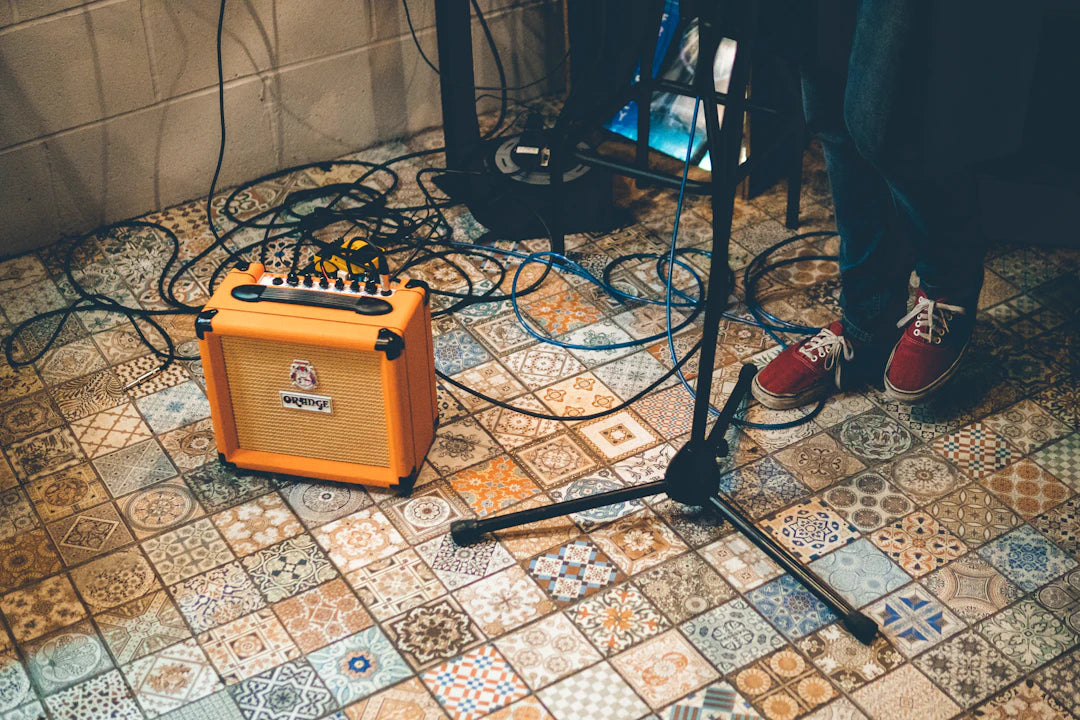Overview
This guide explores how to effectively match guitar pickups with amplifiers for optimal sound. Key topics include understanding different types of pickups (single-coil vs. humbucker), choosing the right amplifier type (tube, solid-state, modeling), best practices for pairing, and the importance of impedance matching. It emphasizes experimenting with EQ settings, effects pedals, and setup considerations like string choice and nut/bridge adjustments. Ultimately, finding your unique sound involves testing combinations and embracing individual preferences.
Frequently Asked Questions
1. What are guitar pickups and how do they work?
2. What are the main types of guitar pickups?
3. What types of amplifiers are there and how do they differ?
4. How important is impedance matching between pickups and amplifiers?
5. What factors should I consider when choosing the right amplifier for my pickups?
When it comes to achieving the perfect tone, understanding how to match your guitar pickups with amplifiers is essential. Many players invest a lot of time and resources into selecting the right guitar for their style, but they often overlook the importance of pairing their guitar pickups with the right amplifier. This guide will walk you through efficient practices to ensure your sound is as rich and full as it can be.
Understanding the Basics of Guitar Pickups
Before diving into the world of amplifiers, it’s crucial to have a solid understanding of guitar pickups. Pickups are essentially the heart of your electric guitar, converting string vibrations into electrical signals that eventually reach your amplifier. Different types of pickups, such as single-coils and humbuckers, have distinct tonal characteristics that can significantly influence the overall sound of your guitar setup.
Types of Guitar Pickups
There are primarily two types of guitar pickups:
- Single-Coil Pickups: Commonly found on Stratocaster models, single-coil pickups are known for their bright, clear sound and crisp high frequencies. They excel in styles like blues, rock, and pop.
- Humbucker Pickups: Typically positioned on guitars like Les Pauls, humbuckers produce a thicker, warmer sound by using dual coils to cancel out unwanted noise and interference, making them perfect for heavier styles like hard rock and metal.
Choosing the Right Amplifier
Matching your pickups with the right amplifier type can make all the difference in achieving your desired sound. Here are some key factors to consider when choosing an amplifier:
Amplifier Types
There are three main types of amplifiers:
- Tube Amplifiers: Renowned for their warm, natural sound, tube amps are favored by many musicians for their dynamic response and rich harmonic content. They generally work well with both humbuckers and single-coils but excel with warmer pickups.
- Solid-State Amplifiers: These amplifiers use transistors to amplify the signal. They provide a more consistent sound and are often more robust than tube amps. Solid-state amps can work well with brighter pickups, such as a Stratocaster pickup set.
- Modeling Amplifiers: Utilizing digital technology, these amps replicate the sound characteristics of various amplifier types. They are versatile and cater to musicians looking for a wide array of tonal options.
Best Practices for Matching Pickups and Amplifiers
Now that you have a foundational understanding of guitar pickups and amplifiers, let's explore best practices for making sure they complement each other optimally:
Know Your Musical Style
The first step in matching pickups with the right amplifier is to consider your musical style. Different genres respond uniquely to various combinations of pickups and amplifiers. For instance, if you primarily play blues or classic rock, using a tube amplifier paired with a humbucker-equipped guitar can bring out the warmth and sustain characteristic of those styles. On the other hand, if you’re into pop or funk, a single-coil pickup, such as those from a Stratocaster pickup set, will shine through a solid-state amp.
Experiment with EQ Settings
Understanding and controlling the EQ (equalization) settings on your amplifier is essential for achieving the best sound. Here are some tips to help you adjust the EQ:
- Bass: Lower frequencies add fullness to your tone. If using single-coils, be cautious; too much can make your sound muddy.
- Mids: Emphasizing mid frequencies can create a more present sound, especially beneficial for solos.
- Treble: This controls the brightness of your tone. While it can make your sound crisp, overdoing it with single-coils can lead to harshness.
Understanding Impedance Matching
Impedance plays a pivotal role in ensuring that your guitar pickups and amplifier work harmoniously. It is vital to ensure that the impedance levels match to avoid signal loss or distortion. Most electric guitars have an output impedance between 5k and 15k ohms, which works well with the input impedance of most amplifiers. However, some models may vary, so it’s important to check specifications.
Choosing the Right Volume Settings
Volume settings on your amplifier can greatly alter how your tones interact with your pickups. A lower volume setting may yield a cleaner sound, which is perfect for single-coils. In contrast, higher settings can introduce natural compression and saturation, often creating a rich, full-bodied tone ideal for humbuckers.
Combining Effects Pedals
Using effects pedals in your setup can also influence how well your pickups match with your amplifier. When considering pedals, think about the following:
Understanding How Pedals Affect Tone
Effects pedals can enhance or alter your guitar signal before it reaches the amplifier. For instance:
- Dirt Pedals: Overdrive or distortion pedals accentuate the tonal qualities of your pickups. Pairing a humbucker with a well-tuned distortion pedal will help to smooth out high frequencies and provide a robust, powerful tone.
- Modulation Pedals: Effects like chorus, flanger, or phaser can add depth to your sound. Single-coil pickups often respond brilliantly to these effects, resulting in shimmering, vibrant tones.
- Delay and Reverb: These effects can add space and character to your tone, making them a great match for any setup. Ensure your amp can handle the additional processing without diluting your core tones.
Tuning and Setup Considerations
The physical setup of your guitar and the condition of your strings are essential factors in maximizing your sound. Here are some leveling tips:
String Choice
Believe it or not, the type of strings you use can influence your tone significantly. Lighter gauge strings will feel easier to play but may produce a thinner sound, particularly with single-coil pickups. Conversely, heavier gauge strings can provide a fuller tone, offering a better match for humbuckers.
Nut and Bridge Setup
The nut and bridge height can affect the overall playability and tone. If you’re using a Stratocaster pickup set, ensure that the pickups are set at the correct height to capture the best frequencies. Lowering pickups can help eliminate feedback, while raising them can boost tonal output.
The Importance of Quality for Guitar Pickups
Quality matters. Opting for guitar pickups made in America ensures a higher likelihood of craftsmanship and consistency in your tone. Brands renowned for their meticulous production processes typically result in better sound quality and reliability, which plays a significant role in how well they pair with your chosen amplifier.
Testing Different Combinations
Ultimately, the most effective strategy for pairing your guitar pickups and amplifiers is to test various combinations. Each player has unique preferences that may lead them to discover unexpected pairings that work cribs initially thought incompatible. Here are a few methods to try:
- Prioritize Comfort: Choose setups that feel good to you. Whether you prefer a classic tube amp, a solid-state powerhouse, or modern modeling options, comfort leads to better performance.
- Focus on Frequency: Play what feels right, not just what sounds right. Trust your ears and your instinct.
- Document Your Findings: Keeping a log of what works and what doesn’t can be invaluable as you continue to refine your gear choices.
Embrace Your Unique Sound
The journey of finding the perfect match between your guitar pickups and amplifier is one of experimentation and exploration. Don’t be afraid to step outside conventional boundaries and develop a sound that is uniquely yours. You may find an unexpected compatibility that takes your music to new heights.
As you move forward, keep in mind the foundational principles covered in this guide, and feel free to revisit as you refine your setup. It's your musical journey—make it resonate with individuality, and let your gear tell your story!
Linked Product
Odyssey Traditions 1957 Stratocaster Pickup Set
The Odyssey Traditions 1957 Stratocaster Pickup Set is designed to enhance the tonal quality of your guitar, providing a classic sound suited for a variety of musical styles. Its construction focuses on delivering clear, articulate tones while maintaining the warmth often desired in vintage pickups. This set is an excellent choice for musicians looking to match their amplifiers effectively, ensuring optimal performance and sound clarity.
View ProductExplore the world of another Shopify or Wix store owner. Visit their captivating online store. Keep in mind that this is a promotional link, and we are not responsible for the content of the linked store.











